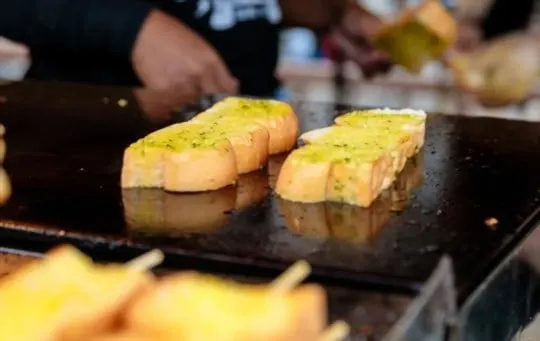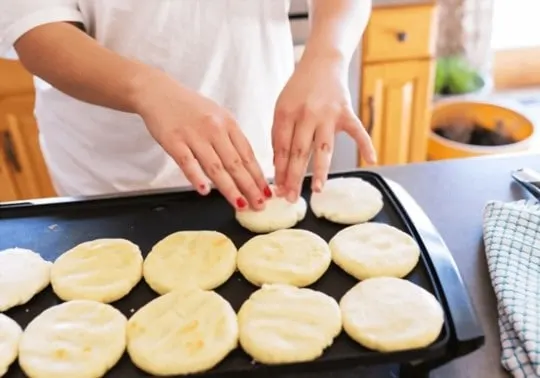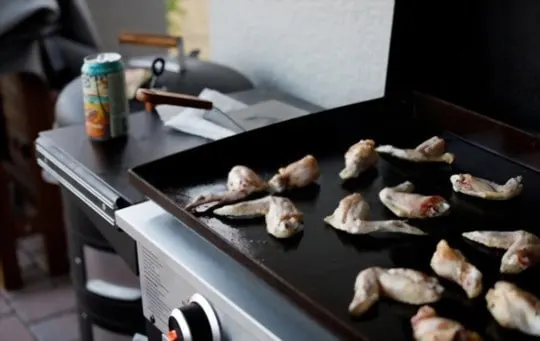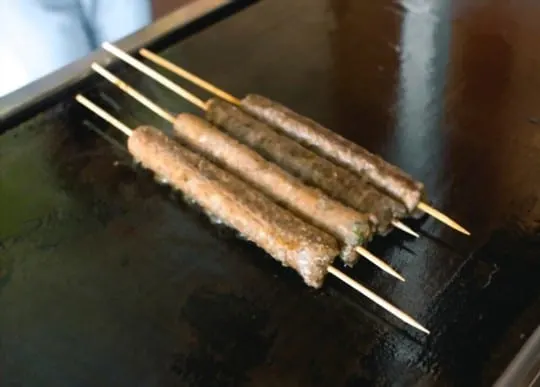Flat tops and griddles both sizzle in the kitchen, yet they serve up flavors in their own unique ways.
We’ve all been there, flipping pancakes and wondering if the tool beneath our spatula is doing our breakfast justice. Quick fact: the surface you cook on can majorly influence the outcome of your meals.
I remember the first time I tried to make the perfect grilled cheese. The flat top was a game changer. Its even heat turned my usual soggy sandwich into a crunchy, golden masterpiece.
Griddles, on the other hand, are all about versatility. Ever tried cooking eggs, bacon, and pancakes all at once? That’s the griddle’s superpower.
Deciding between the two shouldn’t be a kitchen conundrum. It’s about what’s cooking and how you like it served.

What’s Flat Top Grill?

A Flat Top is a kitchen cooking appliance that features a flat cooking surface rather than the typical grill grates.
The surface can be composed of materials such as stainless steel, chrome, or cast iron and heats evenly across all areas.
The design allows for versatility in cooking various food items, such as bacon, eggs, pancakes, stir-fry dishes, and more.
Additionally, the flat top is easier to clean than traditional grills and has a larger cooking area.
What’s Griddle Grill?

A griddle is a flat cooking surface that is commonly used in both commercial and home kitchens.
It can be made of cast iron, aluminum, or stainless steel and has a smooth surface that heats evenly.
The temperature on the griddle can be adjusted to cook different types of food at various temperatures.
Griddles are versatile and can be used for cooking pancakes, eggs, burgers, bacon and much more.
They are easy to clean and maintain and are an essential tool in any kitchen.
Differences Between Flat Top Grill and Griddle Grill

When it comes to cooking surfaces, the debate between the flat top and griddle has been going on for years.
Both offer their unique cooking experience and can produce delicious results.
Flat tops provide a large cooking surface with consistent heat distribution while griddles allow for easy grease removal and versatility in the food items that can be cooked.
Flat tops excel at searing meat while maintaining its juiciness, making them ideal for steaks, burgers, and other grilled meats.
On the other hand, griddles are perfect for cooking delicate items such as eggs and pancakes due to their flat surface which eliminates high edges.
As both surfaces are different in nature, choosing one depends on individual preference and what type of dishes you plan to cook.
Flat tops are recommended for larger meals that require fast-paced cooking while griddles offer versatility that can accommodate a range of meal options.
Design and Construction
The structure and build of a flat top or griddle have a significant impact on their functionality.
The former typically comes with an even and sturdy surface that provides optimal heating, while the latter features ridges or grooves, which may limit space for cooking certain foods while maintaining consistent heat.
Additionally, the thickness of the metal used in their construction plays a significant part in heat distribution.
An ideal flat top or griddle should feature high-quality materials that improve its overall durability and longevity.
Heat Distribution and Control
The even distribution of heat and control over the cooking surface is crucial in determining the final outcome of a dish.
When considering the choice between a flat top and griddle, this factor plays a significant role.
While both options provide excellent heat distribution, the flat top provides more versatility in controlling temperature zones.
The smooth surface allows for easier movement of food and less chance of it falling through the grates.
With consistent temperatures across the whole cooking surface, you can cook multiple dishes simultaneously without worrying about uneven cooking.
Versatility and Cooking Methods
Featuring an array of cooking techniques for various recipes, the choice between a Flat Top and Griddle is essential.
With different abilities that depend on surface area, one can bake, grill, sauté and fry among other methods on either cooking equipment.
While both have flat surfaces, the Griddle has better heat distribution with its higher oil retention, ultimately producing tastier results in less time compared to the Flat Top that has flatter heating.
Additionally, the versatile nature of the Griddle allows users to cook breakfast items like bacon and eggs while also preparing lunch or dinner dishes.
On top of that, the Flat Top excels at handling sticky foods such as cheese and sauces, making it ideal for meat dishes such as burgers and hot dogs.
It’s also perfect for creating a crust on chicken wings or searing steaks.
Maintenance and Cleaning
After prolonged usage, keeping your cooking equipment clean and well-maintained is crucial for durability and hygiene.
Here are some ways to ensure proper upkeep of the cooking surface.
- For flat tops, remove debris with a scraper after each use. Wipe with a soft cloth and mild detergent solution. Use a non-abrasive cleaner to avoid scratches.
- For Griddles, remove grease with a spatula while the griddle is still hot. After cooling down, scrape off any excess residue and wipe with a damp cloth or paper towel.
- Both cooking surfaces should be seasoned regularly with oil to prevent rusting, enhance flavor, and reduce sticking.
When cleaning the drip tray and underside of the appliance, make sure it’s unplugged and cooled down completely.
Regularly check for any signs of damage or wear on grates or coils to ensure effective heat transfer.
Taking preventative measures will save you time in repairs and replacement costs in the long run.
Similarities Between Flat Top Grill and Griddle Grill

Flat Top and Griddle have striking similarities in terms of usability, reliability and functionality.
Both are available in electric, gas and hybrid versions.
They are convenient for large scale cooking operations because of their spacious surface area that allows the user to cook multiple dishes simultaneously with minimum space constraints.
Moreover, both appliances are easy to use with a simple layout design, making them an ideal choice for beginners.
Additionally, Flat Top and Griddle can be used for different types of cooking techniques like stir-frying, sautéing, boiling, braising or slow-cooking.
They also give the ability to adjust temperatures efficiently based on specific recipe requirements with ease.
The non-stick coating on both surfaces reduces the need for excess oil or butter, hence promoting healthy eating.
However, it’s important to note that there are slight differences between these two appliances that may influence your final decision on which one to purchase.
For instance, a flat top is better suited for consistently heating up large items like pancakes and burgers while a griddle offers greater depth control owing to its ridges which gives food a grill marks effect.
Overall, choosing between these two appliances depends on personal preferences regarding size requirements, style of cooking and how frequently you intend to use them which needs careful consideration before making any purchase decision.
Considerations for Choosing Between Flat Top and Griddle
When looking to buy a cooking appliance, one may wonder which option is a better fit – Flat Top or Griddle? Both have unique features and benefits that should be considered before making the final decision.
A crucial factor to consider is the type of cuisines that one wants to cook regularly, as both appliances are suitable for different types of foods.
Additionally, the time required for cleaning and maintenance should also be considered, as it can affect the overall usability of the appliance.
Another important consideration when choosing between a Flat Top and Griddle is the cooking capacity.
Generally speaking, griddles tend to have more cooking space than flat tops, making them an ideal choice for catering large crowds or large family gatherings.
However, if space is limited, a flat top may be a better option as they are typically smaller and take up less room in a kitchen.
It’s also important to note that some models combine both flat tops and griddles into one unit, providing users with added flexibility in their cooking options.
In addition to these considerations, one should also evaluate their budget before making the final selection.
While some models can be expensive, others offer great value at affordable prices.
Cooking Style and Preferences
Different cooking methods cater to different cooking styles and preferences.
One can choose between a flat top or a griddle based on what they require in their cooking process.
Both have unique features that make them ideal for a specific type of food preparation.
A flat top provides an even, consistent surface perfect for searing meat or cooking pancakes.
It also has ample space ideal for large-scale meal preparation, making it the best choice for commercial kitchens.
Meanwhile, a griddle’s ribbed surface works well for char marks on steaks and grilling sandwiches or other foods with fillings.
In terms of versatility, a flat top wins because it can be used as both a stove and a grill depending on the user’s preference.
Griddles are mainly designed for dry heat cookery, which limits their functions.
Overall, choosing between a flat top and a griddle ultimately depends on personal preferences and specific culinary needs.
Both have unique advantages that cater to different culinary styles; hence there is no one-size-fits-all solution when it comes to selecting either option.
Available Space and Budget
For those with limited resources and space, deciding between a Flat Top and a Griddle could be challenging.
The choice is often dependent on factors such as available Space and Budget.
- First, consider the location of the cooking station because both appliances have different footprints that require varying degrees of countertop space.
- Determine your financial abilities because some appliances come at a premium, while others are more affordable.
Another factor to take into account is the design of your kitchen setup since sufficient room for cooking needs to be present to ensure optimal utilization of either appliance.
With limited counter space available, it may be more suitable to use a griddle that can be conveniently stored away when not in use.
On the other hand, if you have ample counter space, a flat top would be ideal.
In addition to budget and space restrictions, consider the type of food being cooked when selecting an appliance.
Both appliances have distinct advantages when it comes to specific dishes being prepared; therefore, it’s important to choose carefully depending on the menu preferences.
Ultimately, whichever appliance you decide to use will depend on how well it fits into your kitchen setup and how frequently it will be utilized.
Ease of Use and Maintenance
When it comes to operating and maintaining cooking equipment, there are various factors to consider.
The level of ease involved in using and taking care of these appliances becomes crucial over time.
For instance, cleaning up, performing regular maintenance, and even handling the machine play significant roles.
When we compare flat top and griddle cooking options with this perspective, there are several differences to observe.
Flat tops provide an easier surface to clean due to their smoothness and limited grooves.
If food spills or debris accumulates on the surface, it can be wiped off efficiently without much effort.
On the other hand, a griddle’s complexity may require more elbow grease during cleaning.
Moreover, flat tops don’t require a lot of additional work in terms of maintenance as long as you regularly wipe them down.
However, maintenance also depends on the kind of usage involved; frequent use may cause wear and tear in equipment that needs further attention from professionals.
Additionally, a sturdy material choice adds to its durability and efficient working life span- this is where griddles have an advantage.
The layered steel construction employed in most griddles creates a reliable machine with fewer damages than other variants.
Pros and Cons of Flat Top and Griddle
Cooking surfaces play a critical role in professional and home cooking.
Choosing the right one can impact your dish’s taste, texture, and appearance.
Here, we present an analysis of cooking on flat tops versus griddles regarding their advantages and drawbacks.
On the one hand, cooking on a flat top offers several benefits.
It features a spacious surface that can cook multiple dishes simultaneously.
Plus, it heats evenly, making it ideal for sautéing vegetables, frying meats or seafood.
On the flip side, cleaning is somewhat tricky because any spills or grease sputters need to be regularly wiped off as they occur; otherwise, it may cause rust or damage to the flat top.
On the other hand, griddles have their pros and cons too.
For example, they heat faster than flat tops with ample space for preparing larger quantities of food at once like pancakes, bacon strips, and eggs.
However, its small non-flat surface makes it difficult to barbecue bigger cuts of meat like steaks or ribs since they might not cook evenly due to heat compression in high points relative to low regions.
Conclusion
After analyzing the pros and cons of both flat top and griddle, it is evident that the choice depends on one’s cooking needs and style.
Flat tops work well for versatile cooking while griddles are ideal for specific dishes like breakfast foods.
It is important to consider the heat distribution and surface area when selecting between the two options.
Flat tops offer an even heat distribution, while griddles have hotspots.
Griddles, however, have a larger surface area compared to flat tops.
Additionally, factors like maintenance, cost, and durability should be considered before making a decision.
Both options require proper care to maintain their longevity, but flat tops may need more frequent cleaning due to food spills.

Leave a comment